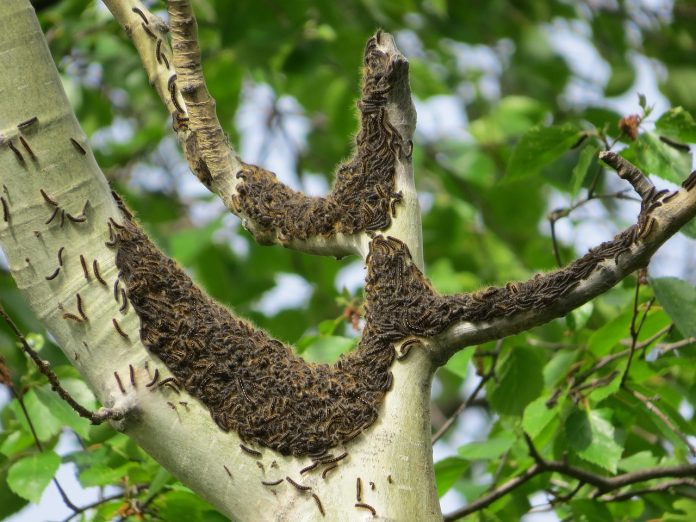Usually, I write about something I’ve seen, because if I’ve seen it, chances are some readers have too. This week, however, I’m wondering about something that’s missing.
Missing
Over the last two weeks, I’ve gotten several phone calls from readers asking if I have seen any tent caterpillars this year. Given a few moments to think about it, I realized I had not.
Usually, I begin seeing the distinctive webs in crotches of small trees in April. They become more conspicuous throughout May, and by June they’re everywhere.
For more than 30 years tent caterpillars have been a reliable sign of spring. But this year I have not seen a single tent or caterpillar. Have you? Let me know if you have.
Meanwhile, here is the tent caterpillar story.
Moths
Tent caterpillars live most of their lives as an egg.
The drab adult moths normally emerge in early summer and live just a few days. The form we know best, the caterpillar, is the most conspicuous.
When the drab moths emerge in early July, blood courses through their unfurling wings. Within a few hours, the inch-and-a-half moths are flying. Their singular mission is follow olfactory cues in search of a mate.
Within 48 hours, the deed is done. Females begin searching for apple, cherry, and other fruit trees.
When she finds the leaves she’s searching for, she lays 200 to 300 eggs around a small twig.
With their lives’ purpose fulfilled, adult moths die just days after emerging from the cocoon.
Eggs
The moths’ future now resides inside an egg case that hardens on the twig. Through the blistering heat of summer and frigid cold of winter, eggs lie dormant, shielded from the elements only by the egg case’s thin protective membrane.
Thanks to a natural antifreeze called glycerol, which makes up 35 percent of the eggs’ weight by January, the embryos remain viable.
Inside the eggs, a biological clock ticks. Spring’s longer days trigger the clock’s alarm. The eggs hatch in April and tiny hungry caterpillars emerge.
Caterpillars
They migrate down the twigs toward the tree’s centrally located crotch and begin spinning and weaving the familiar tent.
The caterpillars work in shifts to build the shelter that consists of many horizontal layers, not unlike a serving of lasagna or baklava. The space between each layer is just large enough to accommodate a group of caterpillars.
When not resting or building the shelter, tent caterpillars march upward along the trees smaller branches in search of fresh tender leaves.
They eat voraciously and grow rapidly. To ensure they can find their way back to the tent, they leave behind a trail of silk.
The combined efforts of the colony yield an extensive network of silky trails that always lead home.
Insect growth is limited by an elastic exoskeleton that stretches only so far. It then splits, and the old exoskeleton is shed. Tent caterpillars molt six times from April through June. Each time hormones control the process to ensure that a new larger caterpillar, rather than a premature moth, results.
After the final molt, the concentration of juvenile hormone ebbs. When the mature caterpillar attains a certain critical weight, the next transformation is much more dramatic.
Cocoons
At this critical size, other hormones kick in. Caterpillars lose their appetite and wander in search of a place to pupate. This is when we see them crossing roads, sidewalks, driveways, trails, and lawns.
Under a log, a rock, or a slab of bark, tent caterpillars undergo their final and most miraculous transformation. First, each caterpillar weaves itself a silky cocoon, being careful to leave a weak spot from which its final incarnation can emerge.
Over the course of the next three weeks, the caterpillar physiologically and biochemically transforms itself from hairy caterpillar into a scale-covered moth.
Adult moths have a single purpose: reproduction. The short-lived moths then die, and a new generation of eggs awaits the following spring. It’s an extraordinary story for such an ordinary creature.














I have had one tent in our woods near Harrisonburg Va. Last year only a couple. Other years many many throughout our woods. I don’t know why but I am grateful.